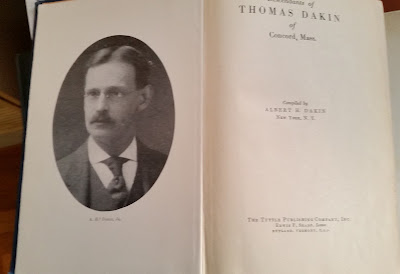It turns out that this was not the first book on the Dakin family that Albert worked on. The undated 79-page book: Descendants of 1 Thomas Dakin of Concord, Mass. and 4 Rev. Simon Dakin of North East, N.Y. 1624-1920, collected and arranged by Albert H Dakin and Emily L Reed.
In 1938, Marion Evans Dakin had an interest in her late husband's family and had inquired about the Dakins from Evelyn West who in March sent her a couple of hand written pages on the early Dakin Family based on this book.
My dear Mrs Dakin -
Here are the jumbled
notes I have in the Dakins --
Sorry I didn't copy more -- but
am sure you will find it Easily
in a good library --
Am so glad to know you
are interested -- It helps
so to fill out records --
Sincerely
Evelyn West
Then in April, Marion receives a copy of the book from Emily L Reed's son.
Marion Evans Dakin
Storrs, Conn.
My dear Mrs. Dakin --
I am sending you
a copy of Dakin Genealogy
which my mother Emily L.
(Clark) Reed complied
some years ago -- A Mr A. H.
Dakin of N.Y. City has an
immense lot of Data of the
Dakin Family which he is
getting together but I don't know
whether he will ever have it
in book form as it will cost
a good sum of money to have
printed in book form --
He is a man over 70 and I
don't think he feels financially
able to have it printed as there
is so much of it. The Dakins
are scattered all over the U. S.
I haven't seen or heard from
him in a number of years
and I don't know whether he
is living yet.
Thank you for the order.
Truly yours.
J. Marvin Reed
Lakeville Conn.
4/18 -- 1938.
Yes, Albert Dakin did have an immense amount of data. When he finally published his 716-page book, it chronicled 6,843 descendants of Thomas Dakin of Concord, Mass.
Marvin Reed is writing to Marion Evans Dakin in April of 1938. His mother, Emily Leora Clark Reed, died twelve years earlier on 1 June 1926 [Descendants of Thomas Dakin of Concord, Mass. Albert H Dakin, 1948, page 205]. Marvin's mother researched the Dakin family and was the co-author with Albert Dakin on this first Dakin family book. Marvin had not heard from Albert for a while, and wasn't sure if Albert was still alive and working on his manuscript. However, we know that he was, since Albert wrote my grandmother in January of 1943, trying to verify and update our family history.
He ended his letter with "I will greatly appreciate receiving an answer from you as I am anxious to complete my records while I have the ability." He died on 14 March 1945 at the age of 79 [Descendants of Thomas Dakin of Concord, Mass. Albert H Dakin, 1948, page 188].
The first Dakin family book, followed one line of descent from the original family settler Thomas Dakin, continuing through that of Thomas' great grandson, the Rev. Simon Dakin. Beginning with the 4th generation [that is why the title includes "... 4 Rev. Simon Dakin of North East, N.Y."], only the descendants of this one great grandson were included. Marion ordered this earlier book in 1938, and unfortunately the book didn't include her husband Rob's ancestor, Timothy who went west to New York and joined the Quakers in Oblong, New York. Timothy was a brother of the Rev. Simon Dakin who also went west to New York but was pastoring in another eastern New York town and it was his descendants who are in this book.
Marion shared the first Dakin book with her son Ted, even though he wouldn't have found his family in it. I remember he loved quoting the Dakin motto:
Strike Dakyn the Devils in the hemp.
I have no idea what that means, but it is in both Dakin books.So, when Albert H Dakin's niece, Mrs. H B Yamagata, finally published the Descendants of Thomas Dakin of Concord, Mass. in 1948, did Marion purchase the family history book that included her husband?
Unfortunately not. I don't know if she even knew about it. Many years after she died, I purchased it from a used book store. A friend of the family called me to say that he heard that "if you were a Dakin in the U.S. then your family should be in this book because every Dakin was descended from one family in Concord." Willie Hills had met another person named "Dakin" and he commented that he knew only one other Dakin. She said that my family ought to be in that book too, so our dear friend Willie called me to tell me about it.
The link to this page is http://genea-adventures.blogspot.com/2017/02/oh-there-was-earlier-dakin-family.html
©2017, Erica Dakin Voolich








































